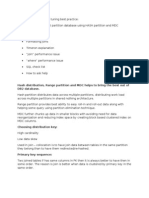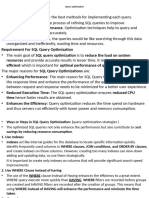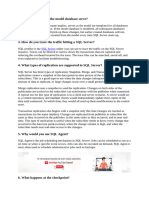Dbms Optimization
Uploaded by
Ashish MishraDbms Optimization
Uploaded by
Ashish MishraFor any production database, SQL query performance becomes an issue sooner or later.
Having long-running queries not only consumes system resources that makes the server and application run slowly, but also may lead to table locking and data corruption issues. So, query optimization becomes an important task. First, we offer some guiding principles for query optimization: 1. Understand how your database is executing your query Nowadays all databases have their own query optimizer, and offers a way for users to understand how a query is executed. For example, which index from which table is being used to execute the query? The first step to query optimization is understanding what the database is doing. Different databases have different commands for this. For example, in MySQL, one can use "EXPLAIN [SQL Query]" keyword to see the query plan. In Oracle, one can use "EXPLAIN PLAN FOR [SQL Query]" to see the query plan. 2. Retrieve as little data as possible The more data returned from the query, the more resources the database needs to expand to process and store these data. So for example, if you only need to retrieve one column from a table, do not use 'SELECT *'. 3. Store intermediate results Sometimes logic for a query can be quite complex. Often, it is possible to achieve the desired result through the use of subqueries, inline views, and UNION-type statements. For those cases, the intermediate results are not stored in the database, but are immediately used within the query. This can lead to performance issues, especially when the intermediate results have a large number of rows. The way to increase query performance in those cases is to store the intermediate results in a temporary table, and break up the initial SQL statement into several SQL statements. In many cases, you can even build an index on the temporary table to speed up the query performance even more. Granted, this adds a little complexity in query management (i.e., the need to manage temporary tables), but the speedup in query performance is often worth the trouble. Below are several specific query optimization strategies. Use Index Using an index is the first strategy one should use to speed up a query. In fact, this strategy is so important that index optimization is also discussed. Aggregate Table Pre-populating tables at higher levels so less amount of data need to be parsed. Vertical Partitioning Partition the table by columns. This strategy decreases the amount of data a SQL query needs to process. Horizontal Partitioning Partition the table by data value, most often time. This strategy decreases the amount of data a SQL query needs to process. Denormalization The process of denormalization combines multiple tables into a single table. This speeds up query performance because fewer table joins are needed.
Server Tuning Each server has its own parameters, and often tuning server parameters so that it can fully take advantage of the hardware resources can significantly speed up query performance.
You might also like
- How To Optimize SQL Server Query PerformanceNo ratings yetHow To Optimize SQL Server Query Performance20 pages
- Top 10 SQL Performance Optimization TechniquesNo ratings yetTop 10 SQL Performance Optimization Techniques1 page
- How to monitor and resolve blocking in SQL Server_PDFNo ratings yetHow to monitor and resolve blocking in SQL Server_PDF3 pages
- Optimize_SQL_Queries_for_Better_PerformanceNo ratings yetOptimize_SQL_Queries_for_Better_Performance1 page
- How To Optimize Queries (Theory An Practice) : Cloud Computing Security 101: Learn How To Keep Your Users SafeNo ratings yetHow To Optimize Queries (Theory An Practice) : Cloud Computing Security 101: Learn How To Keep Your Users Safe15 pages
- Snowflake Query Optimization Techniques SnowNo ratings yetSnowflake Query Optimization Techniques Snow13 pages
- Optimizing Database Performance with SQL TuningNo ratings yetOptimizing Database Performance with SQL Tuning4 pages
- Oracle Tuning Pack: Optimize Database Service LevelsNo ratings yetOracle Tuning Pack: Optimize Database Service Levels7 pages
- What Are The Best Mapping Development Practices and What Are The Different Mapping Design Tips For Informatica?No ratings yetWhat Are The Best Mapping Development Practices and What Are The Different Mapping Design Tips For Informatica?29 pages
- Database_Performance_Tuning_and_Query_OpNo ratings yetDatabase_Performance_Tuning_and_Query_Op9 pages
- Instructor: Craig Duckett: Stored Procedures (SQL Server) MysqlNo ratings yetInstructor: Craig Duckett: Stored Procedures (SQL Server) Mysql72 pages
- 6 tips for better sql query optimization (with example code)No ratings yet6 tips for better sql query optimization (with example code)4 pages
- Edgewood Solutions Engineers: Written By: - 11/13/2008No ratings yetEdgewood Solutions Engineers: Written By: - 11/13/20086 pages
- Data Retrieval and Programmability: Querying SQL T-SQL Sybase SQL Server DeclarativelyNo ratings yetData Retrieval and Programmability: Querying SQL T-SQL Sybase SQL Server Declaratively1 page
- SQL Query Tuning and Safe Procedure Writing: Submitted By: - Aman SharmaNo ratings yetSQL Query Tuning and Safe Procedure Writing: Submitted By: - Aman Sharma9 pages
- Performance Tuning Tips For Stored ProceduresNo ratings yetPerformance Tuning Tips For Stored Procedures12 pages
- Research On Database Application Performance Optimization MethodNo ratings yetResearch On Database Application Performance Optimization Method4 pages
- optimizing sql query performance_ a comprehensive guide _ by taran kaur _ women in technology _ mediumNo ratings yetoptimizing sql query performance_ a comprehensive guide _ by taran kaur _ women in technology _ medium15 pages
- Oracle SQL Tuning You Probably Never KnowNo ratings yetOracle SQL Tuning You Probably Never Know8 pages
- Five Performance Hints For Efficient SQLNo ratings yetFive Performance Hints For Efficient SQL7 pages
- What Purpose Does The Model Database Serve?: SQL ServerNo ratings yetWhat Purpose Does The Model Database Serve?: SQL Server10 pages
- Tips For Database Testing: Questions Related To Database StructureNo ratings yetTips For Database Testing: Questions Related To Database Structure4 pages
- 12 sql query optimization best practices for cloud databasesNo ratings yet12 sql query optimization best practices for cloud databases9 pages
- Advanced SQL Performance Tuning: Optimize Your Database WorkloadsFrom EverandAdvanced SQL Performance Tuning: Optimize Your Database WorkloadsNo ratings yet
- The SQL Workshop: Learn to create, manipulate and secure data and manage relational databases with SQLFrom EverandThe SQL Workshop: Learn to create, manipulate and secure data and manage relational databases with SQLNo ratings yet
- 5 Free Alternatives To Microsoft Word - TechrepublicNo ratings yet5 Free Alternatives To Microsoft Word - Techrepublic26 pages
- Android Application To Convert Speech To Text andNo ratings yetAndroid Application To Convert Speech To Text and5 pages
- Delta-Ia HM Iandroid Eremote App Um en 20141027No ratings yetDelta-Ia HM Iandroid Eremote App Um en 2014102710 pages
- 2 Messages: Associate So Ware Engineer (ASE) Job Description ForNo ratings yet2 Messages: Associate So Ware Engineer (ASE) Job Description For3 pages
- Data Fabric Architecture (More Detail) - Version 1.0100% (1)Data Fabric Architecture (More Detail) - Version 1.02 pages
- What Are The Functions of Different Panels in Photoshop. ExplainNo ratings yetWhat Are The Functions of Different Panels in Photoshop. Explain5 pages
- Unit 6: Computer Software: Lesson 1: Introduction and ClassificationNo ratings yetUnit 6: Computer Software: Lesson 1: Introduction and Classification24 pages
- Peoplesoft FSCM 9.2.035 Update Image Manifest For VirtualboxNo ratings yetPeoplesoft FSCM 9.2.035 Update Image Manifest For Virtualbox2 pages
- Flutter: Flutter Flux Implements A Unidirectional Data Flow Pattern That Consists of Actions, Stores, and StorewatchersNo ratings yetFlutter: Flutter Flux Implements A Unidirectional Data Flow Pattern That Consists of Actions, Stores, and Storewatchers15 pages
- Salesforce Limits Quick Reference GuideNo ratings yetSalesforce Limits Quick Reference Guide40 pages

























































































